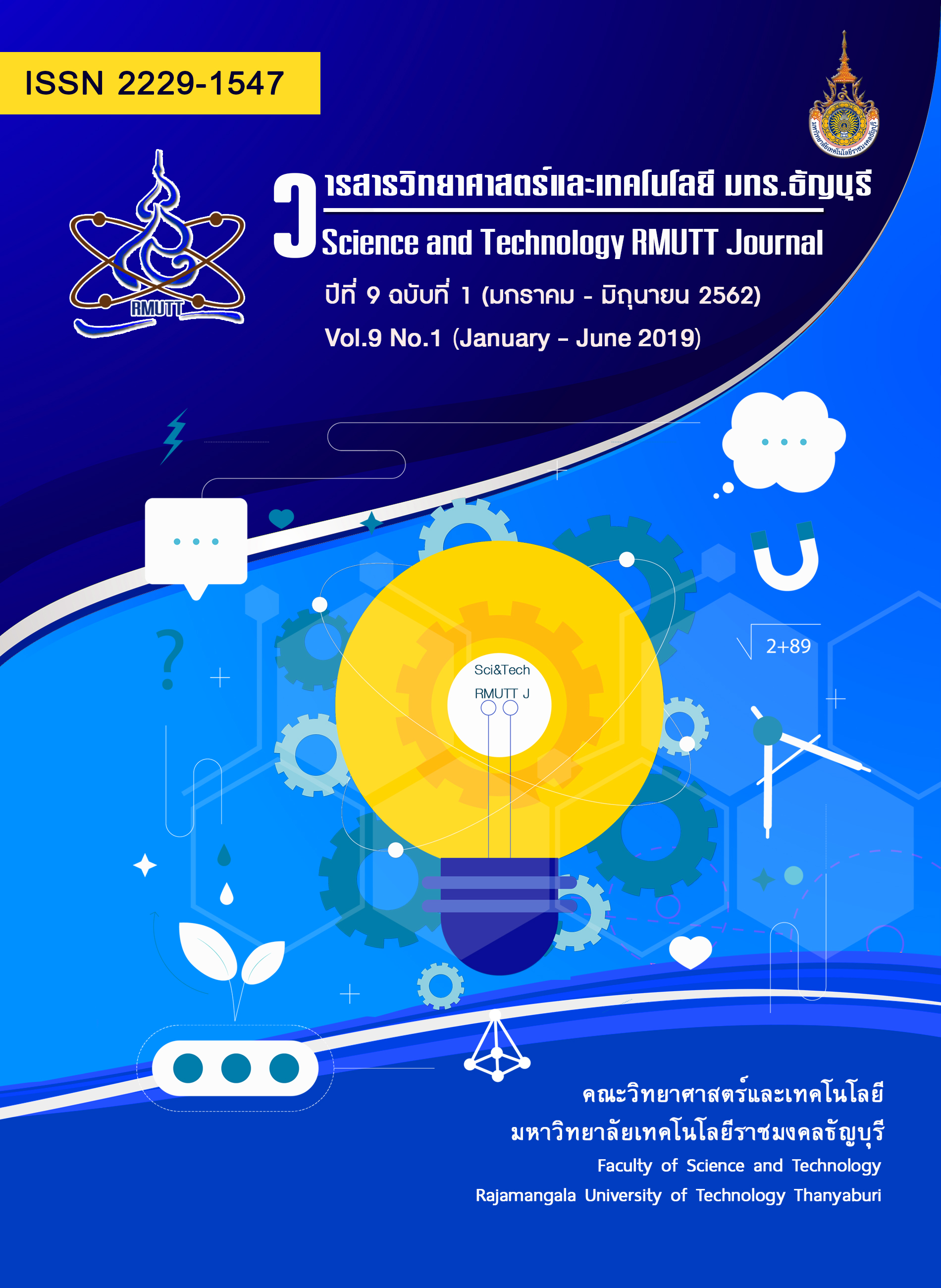Cotton Knit Fabric Dyed with Natural Indigo and UV Protection
Main Article Content
Abstract
The main objective of this research were to 1) study knit fabric structure, physical properties and color values of cotton knit fabric structure undyed (white color) with the cotton knit fabric dyed with natural indigo and 2) compare the effectiveness in UV protection of cotton knit fabric structure undyed (white color) with the cotton knit fabric dyed with natural indigo. Physical properties tested stitch density, fabric thickness, bursting strength, air permeability values were measured before and after washing, color values tested L* a* b* C* and h* values and the effectiveness in UV protection of cotton knit fabric structure undyed (white color) with the cotton knit fabric dyed with natural indigo was then measured as follows: ultraviolet protection factor (UPF), percentage of UVA and UVB transmittance, and percentage of UVA and UVB blockage values were measured before washing, after five washing and 10-hour light exposure in both dry and wet conditions. It was found that the stitch density values of the cotton knit fabric dyed with natural indigo were a little greater than those of the cotton knit fabric structure undyed (white color) when measured before washing while their fabric thickness values of the cotton knit fabric dyed with natural indigo were a higher than those of the cotton knit fabric structure undyed (white color) when measured after washing while their bursting strength values of the cotton knit fabric structure undyed (white color) were a higher than the cotton knit fabric dyed with natural indigo when measured both before and after washing, and air permeability values the cotton knit fabric dyed with natural indigo indigo were a higher than those of the cotton knit fabric structure undyed (white color) when measured both before and after washing.
It was also found that the cotton knit fabric structure undyed (white color) showed unprotect levels of effectiveness in UV protection when tested before and after laundering, light exposure in both dry and wet conditions. While the cotton knit fabric dyed with natural indigo, it was also found that showed very good to excellent levels of effectiveness in UV protection when tested before and after laundering, light exposure in both dry and wet conditions.
Article Details
References
Rieker, J., Guschlbauer, T., & Rusmich, S. (2001). Scientific and practical assessment of UV protection. Melliand Textilberichte, 7-8, E155-156.
Hoffman, K., Laperre, J., Avermaeter, A., Almeyer, P., & Gambichier, T. (2001). Definted UV protection by apparal textiles. Arch Dermatol, 137, 1089 -1094.
Crews, P.C., Kachman, S., & Beyer, A.G. (1999). Influences on UVR transmission of undyed woven Fabrics. Textile Chemist and Colorist, 31, 17-26.
Algaba, I. & Riva, A. (2002). In vitro measurements of the ultraviolet protection factor og apparel textiles. Color Technol, 118, 52-58.
Davis, S., Capjack, L., Kerr, N., & Fedosejevs, R. (1997). Clothing as protection from Ultraviolet Radiation: Which Fabrics is most effective?. Int J Dermatol, 36, 374 -379.
Menzies, S.W., Lukins, P.B., Greenoak, G.E., Walter, P.J., Pailthorpe, M.T., Martin, J.M., David, S.K., & Georgouras, K.E. (1991). A comparative study of fabric protection against ultraviolet–induced erythema determined By spectrophotometic and humen skin measurements. Photodermatol Photoimmunol Photomed, 8, 158-163.
Hoffman, K., Hoffman, A., Hanke, D., Bohringer, B., Schindling, G., Schon, U., Klotz, M.L., & Altmeyer, P. (1998). Sun protection from optimally designed fabric. Hautarzt, 49, 10-16.
ASTM E275. (2003). Practice for describing and measuring performance of ultraviolet, visible. And near- infrared spectrophotometer. ASTM International, West Conshohocken, PA.
Black, S. (2002). Knitwere in Fashion. New York, Thames & Hudson.
Hoxbro, V. (2004). Shadow Knitting. Loveland, CO: Interweave Press.
De Arajo, M.D. (2002). “Weft-Kniting Fabric Design for Technical Application.” Textile Asia. 3(3), 23-27.
Eckhardt, C., & Rohwer, H. (2000). UV protection for cotton fabric. Textile Chem Color, 32(4), 21-23.
Hollingworth, S. (1983). The Complete Book of Traditional Aran Knitting. St. Martin's Press.
AATCC. (2006). AATCC TECHNICAL MANUAL. American Association of Textile Chemists and Colorists : North Corolina.
Sun protective clothing: evaluation and classifiction. Sydney, New South Wales: Standards Australia.
Khaentum, A. (1999). Principle of Experiment. Bangkok: Department of Statistics, Kasetsart University.
Rodphothong, P. (1997). Silk Fabric Dyeing with Fresh Mangosteen Husk. M.S. Thesis, Kasetsart University.
Parisi, A.V., Komlin, M.G., Mutheran, L., Meldrum, L.R, & Randallt, C. (2000). Field-based measurement of personal erythemal ultravoiolet exposure through a common summer garment. Photodermatol Photoimmunol Photomed, 16, 134-138.
Gambichier, T., Avermaete, A., Altmeyer, P., & Hoffmann, K. (2001). In vitro and in vivo measurement the UV protection of dry and wet textiles. Paper presented at: Tenth Annual Meeting of the Protomedicine Society. March 1, Washington, DC.
Osterwalder, U., Schlenker, W., Rohwer, H., Martin, E., & Schuh, S. (2000). Facts and fiction on ultraviolet protection by clothing. Radiat Protection Dosimetry. 91, 255-260.
Sarkar, A.K., & Seal, C.M. (2003). Color strength and colorfastness of flex fabrics dyed with natural colorants. Clothing and Textiles Research Journal, 21, 162-166.
Stanford, D.G., Georgous, K.E., & Pailthorpe, M.T. (1993). The effect of laundering on the sun protection afforded by a summer-weight garment. J Eur Acad Dermatol Venereol, 5, 28-39.






